Thanks to generous funding from the McGill Post-Graduate Students’ Society (PGSS), the Islamic Studies Library was able to convert what used to be a dark corner into a very cozy reading nook:
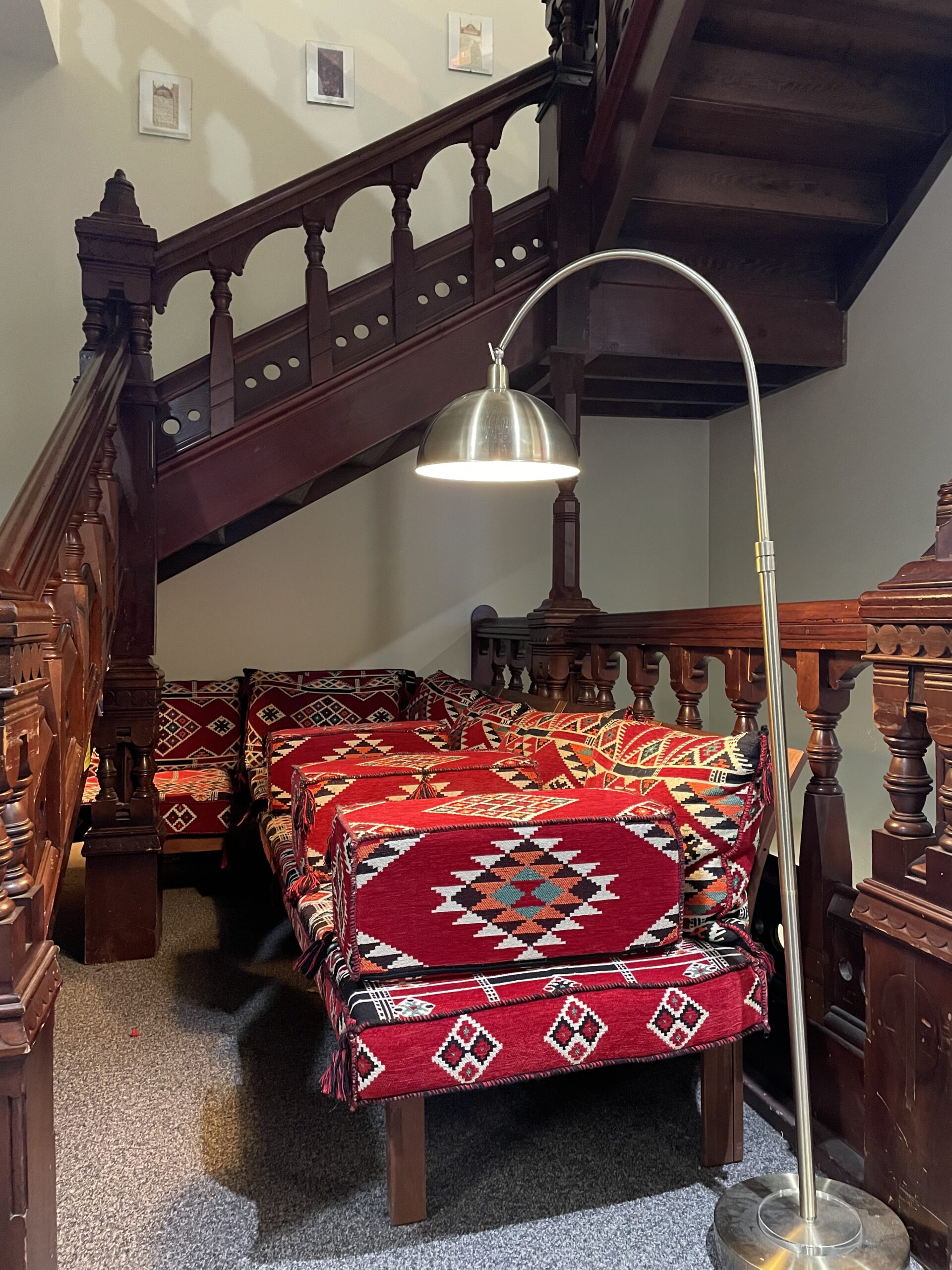
Make sure you check it out at your next visit!


Thanks to generous funding from the McGill Post-Graduate Students’ Society (PGSS), the Islamic Studies Library was able to convert what used to be a dark corner into a very cozy reading nook:

Make sure you check it out at your next visit!
OPenn contains complete sets of high-resolution archival images of cultural heritage material from the University of Pennsylvania Libraries and other institutions, along with machine-readable descriptive and technical metadata.

All materials on OPenn are in the public domain or released under Creative Commons licenses as Free Cultural Works. Materials are free to download and use under the license assigned to each document. OPenn encourages that whenever possible, to cite the website and the holding institution when material are used. Many of the manuscripts on OPenn were digitized through grants and awards from public and private donors.
The data on OPenn is intended for aggregators, digital humanists, and scholars. Many of the images here are available via more user-friendly page-turning applications on institutional websites. OPenn regularly adds new repositories and new documents in order to bring more data to the public. Check back often to see what’s new.
Manuscript cataloging incorporates not only the identification of the author, title, date of origin, and provenance, but also, detailed descriptions intended to aid the palaeographer, codicologist, art historian, historian, and philologist. A description of the manuscript cataloging, with technical and non-technical detail, is given in the Technical ReadMe document.
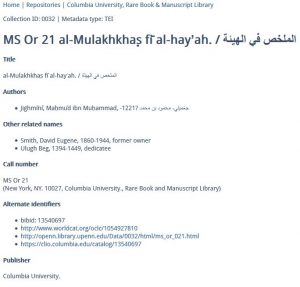
Collection ID: 0032 | Metadata type:TEI MS Or 21 al-Mulakhkhaṣ fī al-hayʼah. / الملخص في الهيئة

Collection ID: 0032 | Metadata type:TEI MS Or 21 al-Mulakhkhaṣ fī al-hayʼah. / الملخص في الهيئة

Collection ID: 0032 | Metadata type:TEI MS Or 21 al-Mulakhkhaṣ fī al-hayʼah. / الملخص في الهيئة

MS Or 21: al-Mulakhkhaṣ fī al-hayʼah. / الملخص في الهيئة (India?, between 1500 and 1840?, Not dated; text was dedicated to Ulugh Beg when first composed; a marginal note on p. 2 also gives a date of A.H. 1256 (1840).)
An OPenn repository is a group of documents belonging to a single institutional collection, all having the same metadata format. OPenn hosts 40 repositories from different institutions, including the University of Pennsylvania several repositories.
An OPenn curated collection is a group of documents belonging to one or more repositories. A curated collection allows for the grouping of items by topic, theme, or project and may not have the same metadata format. OPenn hosts 5 curated collections:
OPenn utilizes standard Google searching techniques such as exact match, combine two search using AND/OR, excluding terms using -, etc. A simple search using keyword: prayers in OPenn search will look like this:

For additional information concerning licenses and use, citation style, alternate access methods and other technical stuff are all available in the OPenn: Read Me.
In this post, two Persian language textbooks will be introduced, they both can be accessed at Islamic Studies Library of McGill.
Persian In Use is an elementary Persian language and culture textbook for learners at college level and is written by Anousha Sedighi and published at Leiden University press.
 This book is designed thematically and offers 10 lessons starting with Alphabet and sound system, covering both written and spoken varieties. Persian In Use offers more than 1200 words and phrases covering highly in use slang, proverbs and idioms; as well as simple explanations of the grammatical features. The daily interactive dialogues provided in this book, help students to learn about contemporary Persian language usage. Literary texts, poems plays, film scripts, and pop songs are offered along with cultural notes. Persian In Use’s goal is to teach and improve learner’s communication skills therefore it provides all four skills of reading, writing, listening and speaking. Students can access to audio materials from companion website: https://sites.google.com/a/pdx.edu/persian-in-use/Audio-Files/lesson-1.
This book is designed thematically and offers 10 lessons starting with Alphabet and sound system, covering both written and spoken varieties. Persian In Use offers more than 1200 words and phrases covering highly in use slang, proverbs and idioms; as well as simple explanations of the grammatical features. The daily interactive dialogues provided in this book, help students to learn about contemporary Persian language usage. Literary texts, poems plays, film scripts, and pop songs are offered along with cultural notes. Persian In Use’s goal is to teach and improve learner’s communication skills therefore it provides all four skills of reading, writing, listening and speaking. Students can access to audio materials from companion website: https://sites.google.com/a/pdx.edu/persian-in-use/Audio-Files/lesson-1.
Persian In Use can be found on the library catalogue from here.
———————————————————————————————————
The Routledge Persian course: Farsi Shirin Ast is a Persian language textbook in two part of (Introductory and Intermediate) and is written by Pouneh Shabani Jadidi and Dominic Prviz Brookshaw. This book is designed mainly for teaching Persian language at university level, though it is a user-friendly language book.
Teaching approach of the book is focused on communicative competence as oppose to the traditional approach of focusing on development of grammatical competence in learning a second language. To achieve its goal the book offers 15 lessons. Each starts with a question as a title followed by new vocabulary and a dialogue (Introductory level) or a text (Intermediate level). Grammatical points are explained and some exercises are offered at the end of each lesson. Audio materials are accessible through companion website Introductory, Intermediate.
Islamic Studies Library of McGill owns these books and they can be found on the catalogue from here for the Introductory and here for the intermediate one.
The collection is arranged in 10 series:
Individual descriptive records (see below) are very detailed showing at first sight if the material is accessible online and allowing to link directly to the digital images. They can be printed, saved, shared and cited directly from the database (export to RIS format, Bibtex, Endnote, Easybib, and Refworks).
Albums can be browsed and images viewed in a custom-made reader displaying one page/one image in the middle column, a clickable list of pages/images on the left-hand side, and a summary of the descriptive record on the right-hand side. Images can be downloaded, printed, enlarged up to actual size and turned left or right.
As in any digital collection use restrictions apply. If the website states that “digital images and files saved from this website should be suitable for most purposes”, more information is available on the Library Reproductions & Permissions page.
Islamic Painted Page is a huge free database of Persian, Ottoman, Arab and Mughal paintings, illuminations, decorated Qur’an pages, book bindings as well as figurative paintings in manuscripts, albums and on single pages. The Database covers examples of the painted page dating from about 700 to 1900 CE and from over 270 collections worldwide.
The database is the work of Stephen Serpell MA MSc, a graduate of Oxford who works in Ipswich, UK. The website has been made possible with support from Iran Heritage Foundation, The Islamic Manuscript Association, German Research Foundation DFG and the Centre for the Studies of Manuscript Cultures (CSMC)
Some interesting features of the Islamic Painted Page:


Also on the homepage, users can click on Go to search form which is an advanced search, allowing them to use any combination of criteria.
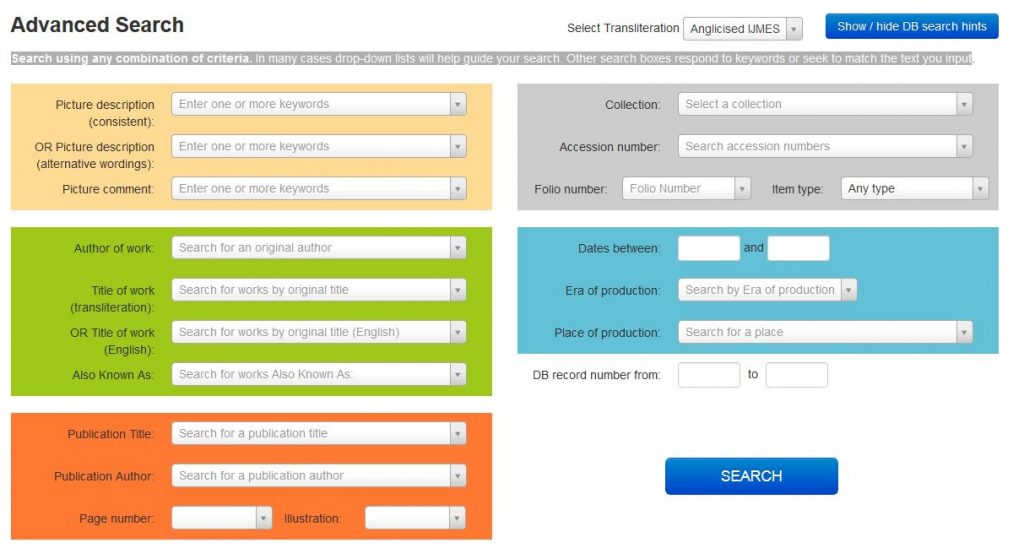 Here is an example of a result page for search by picture description only.
Here is an example of a result page for search by picture description only.
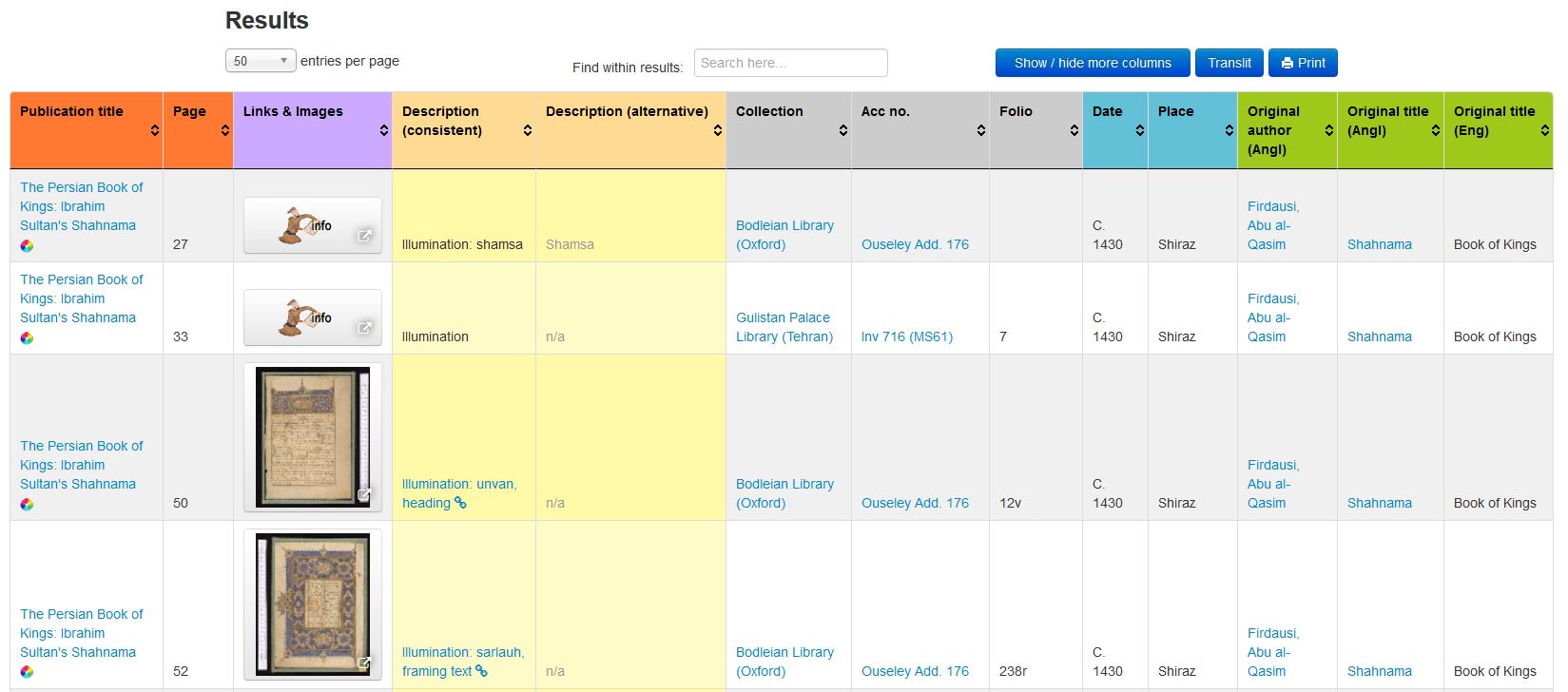

Chester Beatty Digital Collections gives access to part of remarkable treasures that are housed at Chester Beatty library In Ireland. This collection is a database of digitized artworks and manuscripts from different part of the world and includes Persian, Islamic, Turkish and Arabic collection. These invaluable collections of manuscripts was gathered by Sir Alfred Chester Beatty (1875-1968) one of the greatest collector of the twentieth century and a friend to Ireland.
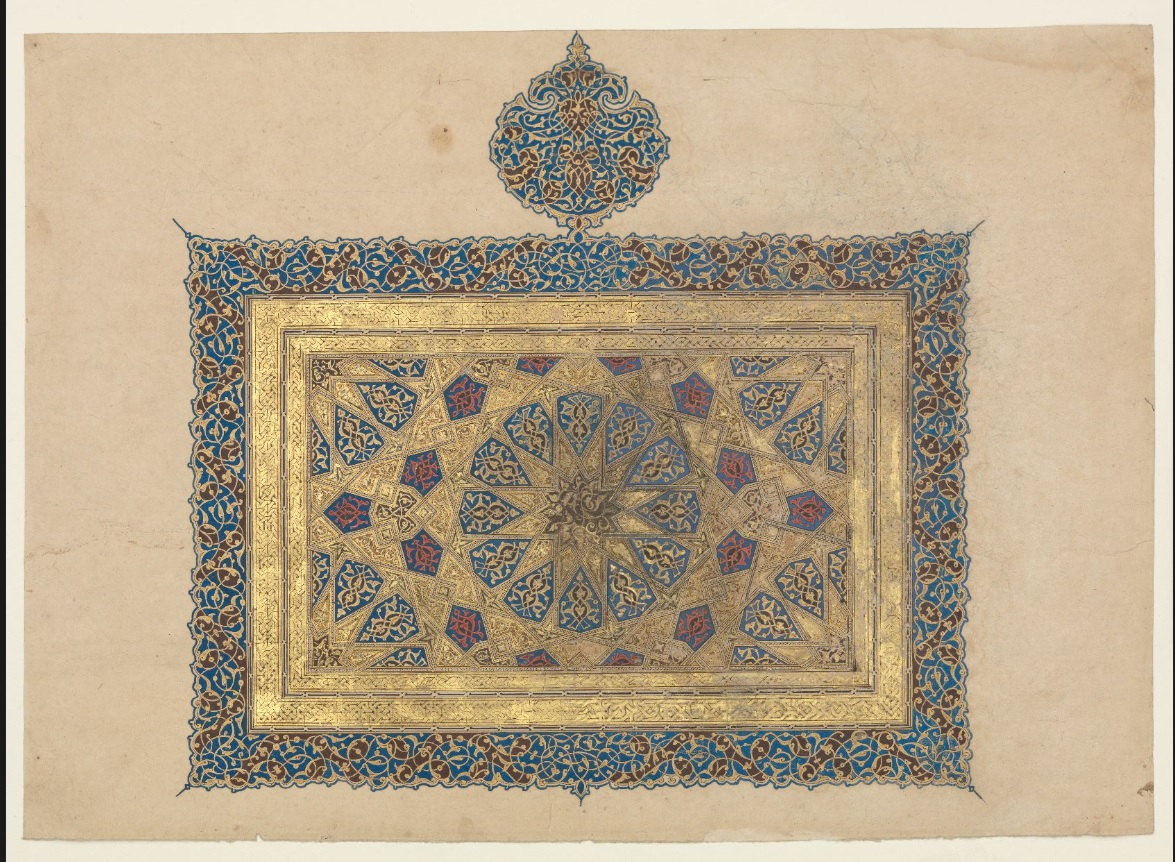
Opening folio from a Qur’an, illuminated by Muhammad ibn Aybak in Baghdad. This full-page illumination marks the beginning of a superb Qur’an volume produced in Baghdad. It is from a thirty-volume set, now dispersed in international collections or lost. Four of the known volumes contain the signature of the renowned illuminator Muhammad ibn Aybak ibn `Abdullah, who also recorded the date and that he was working “in the City of Peace, Baghdad”. From these inscriptions, Ibn Aybak’s work schedule becomes clear: he completed volume two in April 1303, ten in February 1305, and thirteen in October 1305, producing an illuminated volume approximately every three months. Folio from a Qur’an, colours and gold on paper, illuminated frontispiece panel with geometric design of central radiating star with quarter-stars repeated in the four corners, and hasp ornament on right margin, right half of a double-page composition, illumination by Muhammad ibn Aybak, opening folio from volume 25 of a 30-volume Qur’an (volume 25 codex is in Tehran Iran Bastan Museum, 3350),
Sir Alfred Chester Beatty was a young mining engineer in New York with huge interest in collecting European, Persian manuscripts, Chinese snuff bottles and Japanese netsuke. It was in 1914 and during a family trip to Egypt that the Islamic manuscript fascinated him so he expanded his collection to include rare books, richly illustrated material, fine bindings and calligraphy. Beatty’s exceptional collection developed over his life time, it comprises of remarkable Islamic, East Asian and biblical manuscripts, important Persian, Turkish, Armenian and Western European holdings as well as Burmese, Thai and Nepalese manuscripts, and is housed in the grounds of Dublin Castle.
“The Chester Beatty Library is a public charitable trust established under the will of the late Sir Alfred Chester Beatty, who left his Collections in the care of a Trust for the benefit of the Irish people.”
The Beatty’s collection is a great resource for scholars and researchers as well as a cultural attraction for visitors from Ireland and from all around the world, part of which is available online through digital collection.
In 2017, the Chester Beatty started digitizing its collection with the help of digital photographers and a team of museum experts. Each item of this collection has a catalogue record and an informative description to the item. The digital collection is a searchable database; however, it is a growing database therefore it is useful to visit it from time to time.
Today we are highliting three online resources making freely accessible historical maps of the Middle East: Palestine Open Maps, the Perry-Castañeda Library Map collection, and The Afternoon Map.
Palestine Open Maps is a platform making available and searchable historical maps from the British Mandate of Palestine period (1920-1948). Materials come from a number of institutions like the National Library of Israel, the National Library of Australia, the David Rumsey Map Collection. The platform includes a large collection of 1940s survey maps in the public domain “covering the territory at scales of up to 1:20,000. It also offers great search and overlay capabilities highlighting the human, natural, and urban geography transformations over the past century. Initiated in March 2018 by Vizualing Palestine and Columbia University Studio-X Amman, Palestine Open Maps is now maintained and developed by Vizualizing Palestine in collaboration with individuals. More information about the platform, the map collection or terms of use can be obtained here.
The Perry-Castañeda Library Map collection at the University of Texas at Austin includes over 250,000 maps among which a number of historical maps of the Middle East. If only 20% of the overall maps collection has been digitized so far, the effort to make more content available online is continued. Published between 1849 and 1973, The Middle East maps collection cover the Arab World, Turkey and Iran from 500 B.C. to the 1970s. Materials are listed alphabetically by name of locality, and accompanied by a brief description. They can be opened, downloaded or saved in PDF format. More information about the collection or terms of use can be obtained here.
Aleppo [Alep] 1912. From Palestine and Syria… Handbook for Travellers by Karl Baedeker, 5th Edition, 1912.
The Islamic Scientific Manuscripts Initiative (ISMI) is a collaborative project between researchers from the Max Planck Institute for the History of Science in Berlin (Germany) and McGill Institute of Islamic Studies in Montreal (Quebec, Canada) aiming at making available information on Islamic manuscripts in the exact sciences. As such it includes manuscripts in Arabic, Persian, Turkish, and other languages covering a broad range of topics like astronomy, mathematics, optics, mathematical geography, music, mechanics, etc.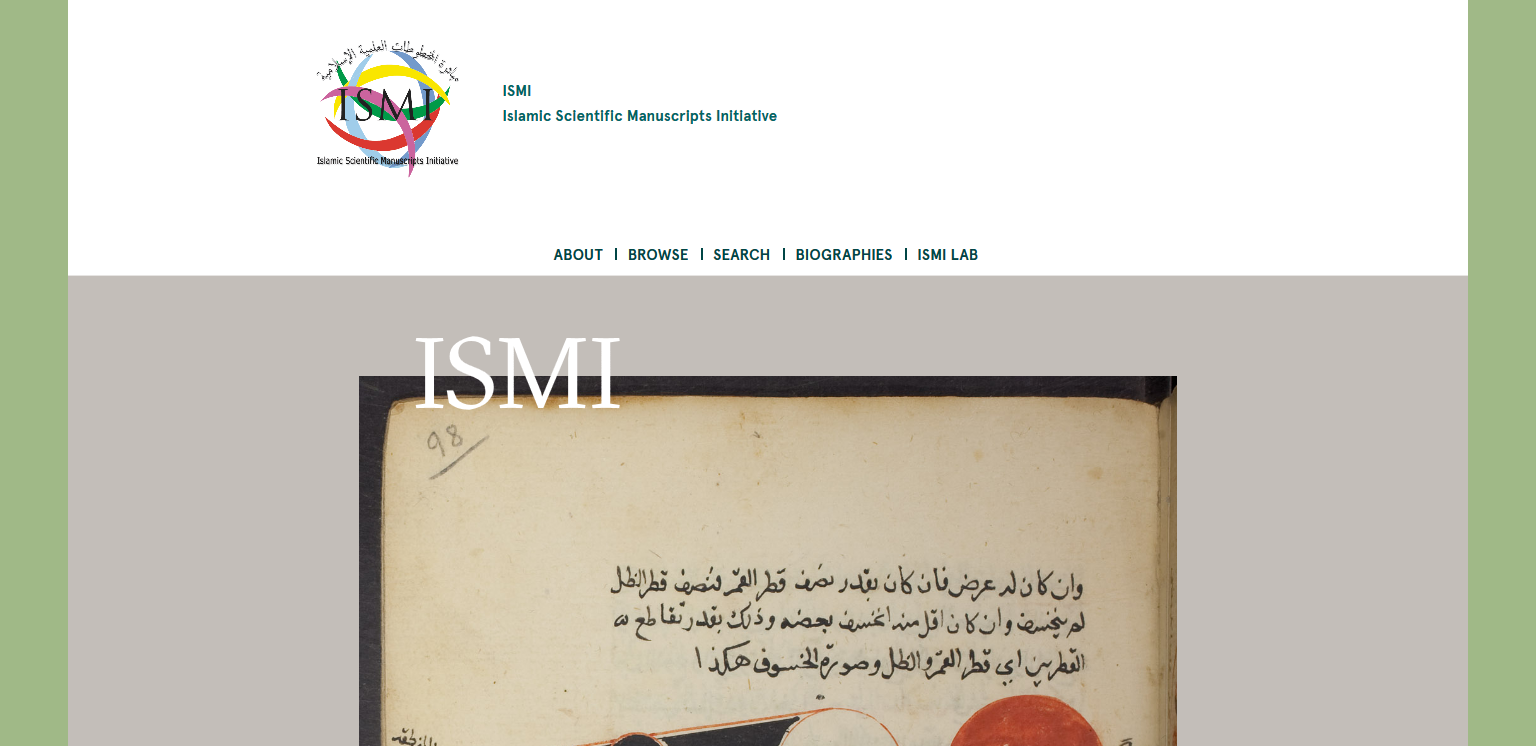
Initiated in 1996, the project was over the years funded by numerous government agencies and private institutions. It is currently supported by the Canada Research Chair in the History of Science in Islamic Societies and Compute Canada.
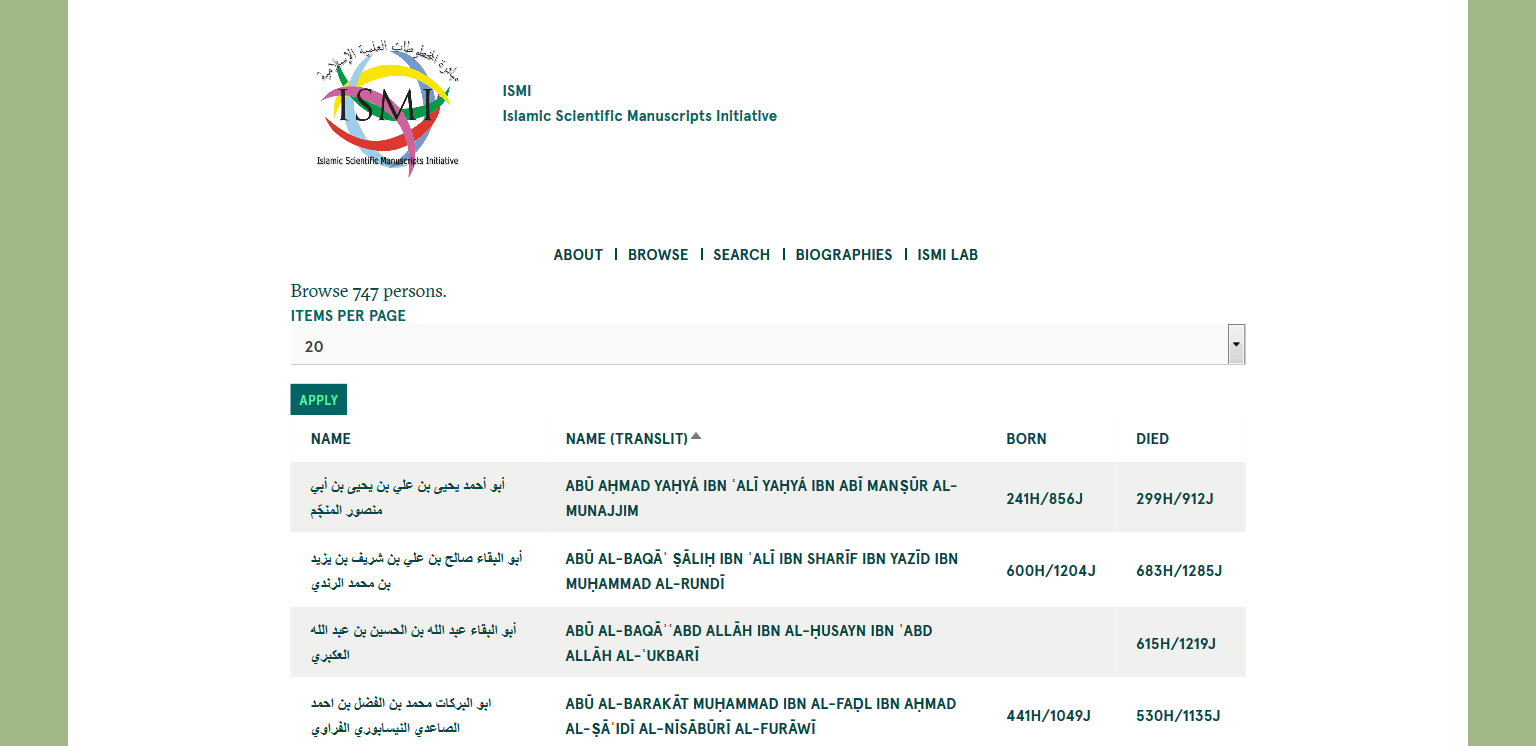
The ISMI database gives access to authors, their works, and extant manuscript witnesses in the various fields of the sciences. links metadata with manuscripts images When possible, digital images are made public. Designed to facilitate research on these materials, the database allows for great flexibility in cross-searching descriptive fields (author, title, place of production, dates, etc.). Alternatively, the database can be browsed by name, title, place of production but also repository, etc. Results always display as a list where items are clickable.
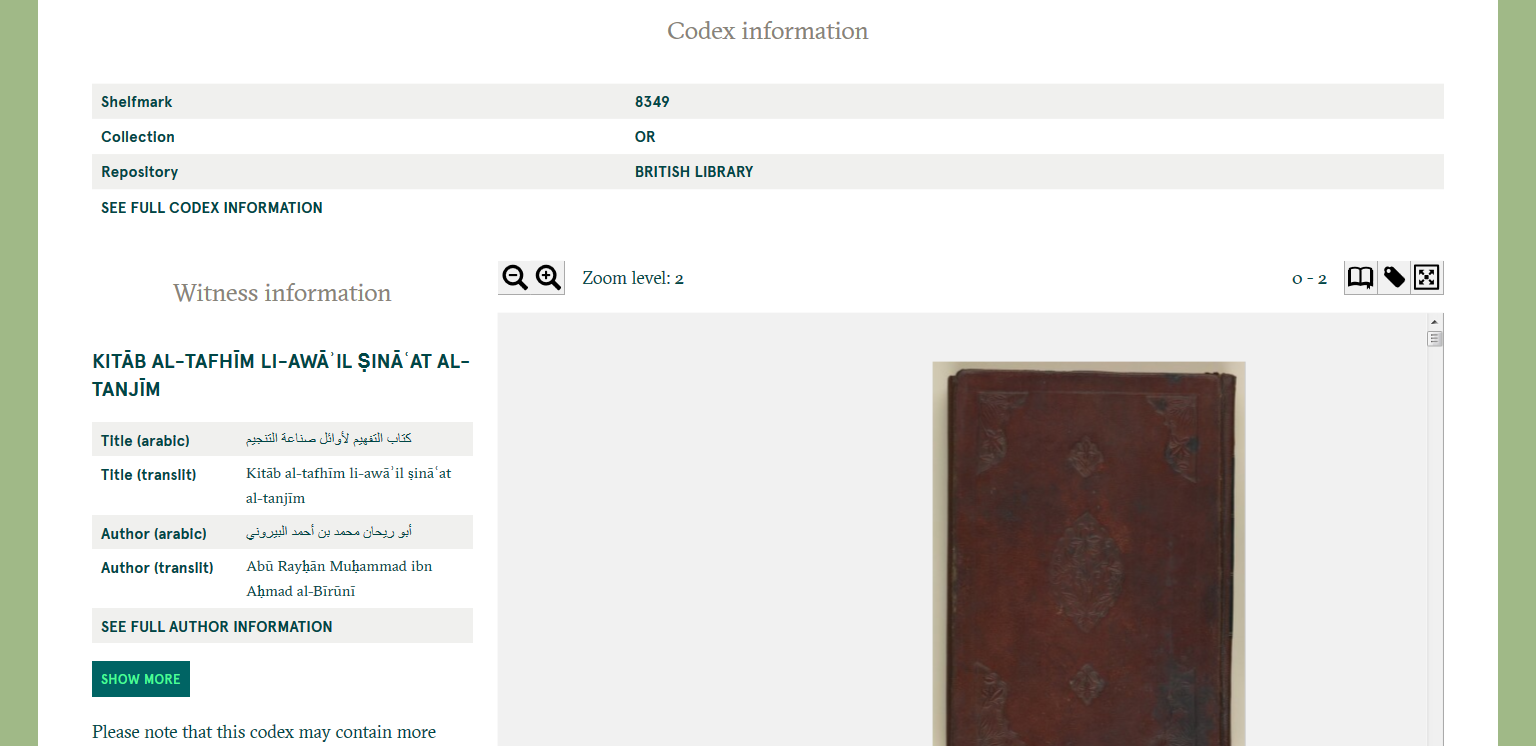
When made public, scanned images display in a reader offering single page, double page or thumbnails view. Digital copies include photographs of the binding, flap, spine and page edges allowing for a better codicological understanding of the codex. “Unless otherwise noted all ISMI content can be used under a Creative Commons Attribution-ShareAlike license: CC-BY-SA.”
Any questions and/or feedback can be sent to ismi-feedback@mpiwg-berlin.mpg.de.
 The Mizan project is dedicated to promoting and supporting public scholarship and research on Muslim societies with focus on topics that are important to Muslims across the globe. The project’s intent is to provide academic resources and insights to the “informed public” on subjects of contemporary relevance to the Islamic world, from an unbiased, fair and academic perspective.
The Mizan project is dedicated to promoting and supporting public scholarship and research on Muslim societies with focus on topics that are important to Muslims across the globe. The project’s intent is to provide academic resources and insights to the “informed public” on subjects of contemporary relevance to the Islamic world, from an unbiased, fair and academic perspective.
The Mizan digital initiative attempts to connect emerging Islamic global civilizations, histories, texts and cultural expressions of Muslim identities with a contemporary audience. In doing so, Mizan connects the past and the future by featuring visual culture, law, classical literature and dialogues with the popular culture of modern Muslim societies. Various Mizan projects explore the history of Muslim societies and Islamic cultures while seeking to remain neutral, that is, with no preference for any sectarian perspective or to any particular orthodoxy or orthopraxy.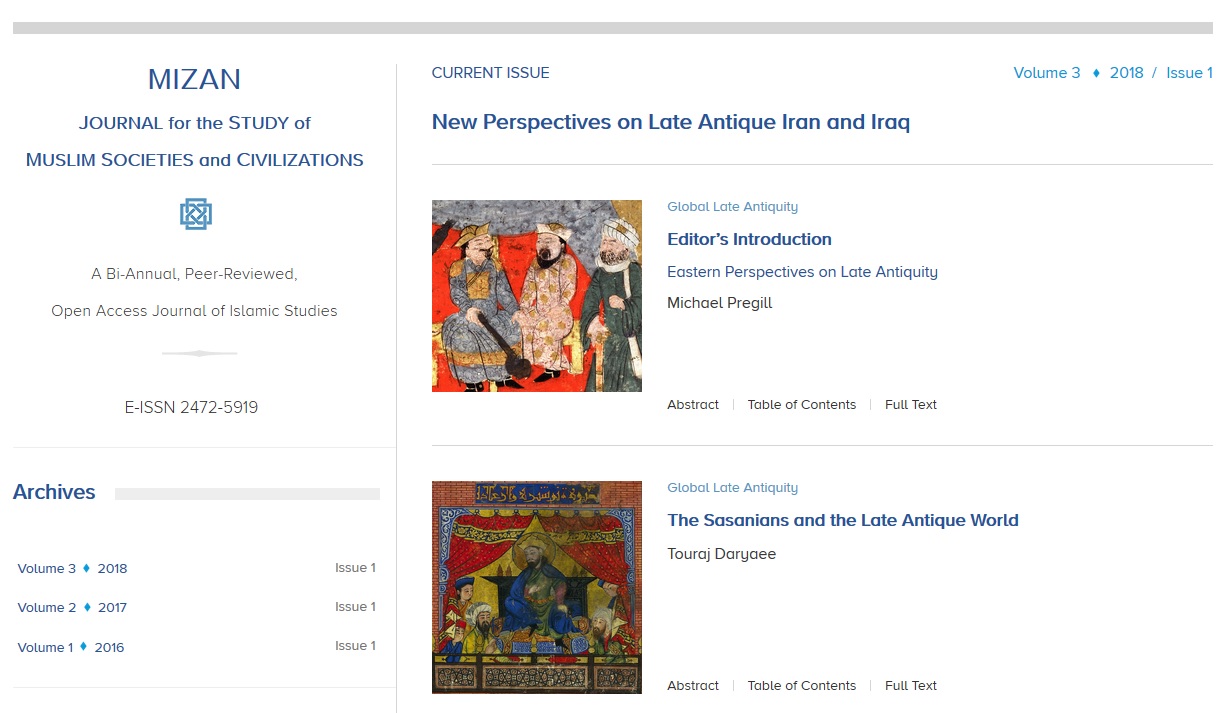
Part of this project’s mission is to provide an open access, bi-annual journal featuring scholarly and peer reviewed articles, called the “Journal for the Study of Muslim Societies and Civilizations”. This journal sheds light on various aspects of the Islamic world in a thematic fashion and with its first issue in 2016.
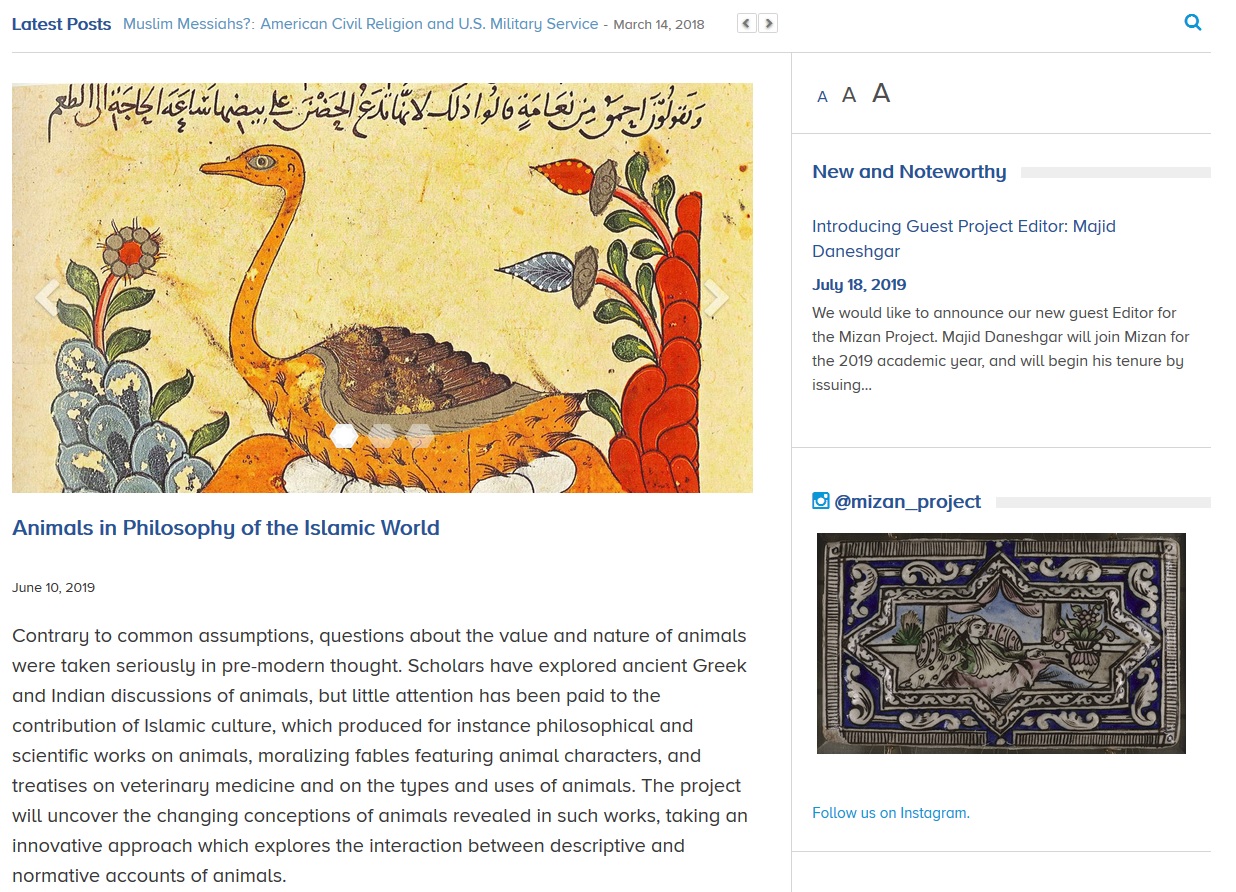 Moreover, short features are published every two weeks on the Mizan project’s website targeting more diverse audiences from the public to scholars and researchers in various fields of Islamic Studies. Stories and various aspects of popular culture in the Islamic World are explored in the Pop section of the site covering Video & Film, Graphic Arts, Music and performances and Politics, Fashion & Identity.
Moreover, short features are published every two weeks on the Mizan project’s website targeting more diverse audiences from the public to scholars and researchers in various fields of Islamic Studies. Stories and various aspects of popular culture in the Islamic World are explored in the Pop section of the site covering Video & Film, Graphic Arts, Music and performances and Politics, Fashion & Identity.
The Mizan project is able to provide full and free access to all its publications due to the support of the ILEX Foundation. An interactive platform offers public engagement via a dynamic annotation tool from which to record comments or questions.
Islamic philosophy is an online resource dedicated to the study of Islamic Philosophy from Abbasid period to the present.
The website was started in July 2001 and contains hundreds of full-length books and articles on Islamic philosophy, ranging from the classical texts to modern works of Muslim philosophy. Materials are available in Arabic, English, French, German and Latin.
There are various areas to explore the website
There is a separate sites for the following philosophers
Al-Ghazali, Ibn Sina, Ibn Rushd, Ibn Taymiyah, al-Kindi, al-Farabi, Muhammad Iqbal.
The site was also a home to the Journal of Islamic Philosophy. This is the first journal born online dedicated to the study of Islamic Philosophy. For more information see the Journal’s page.
The site is also a home to site for Prof. Mashhad al-Allaf.